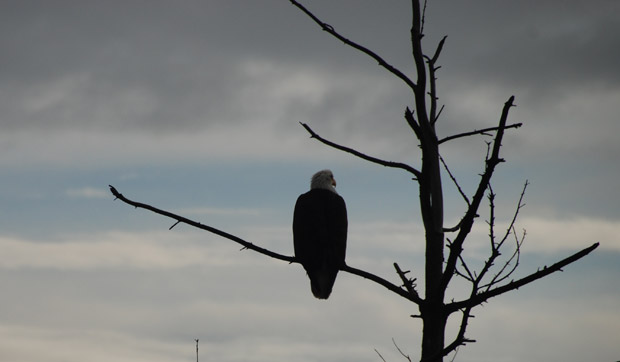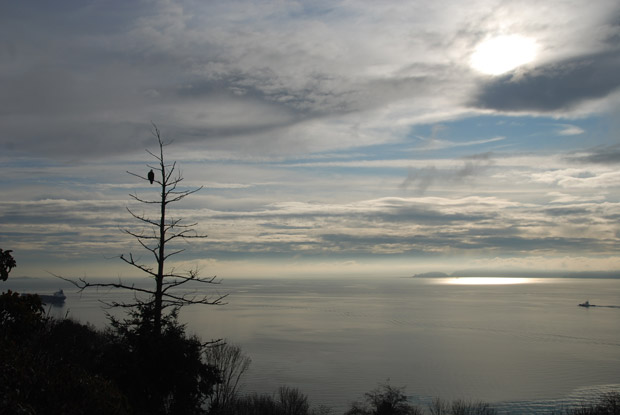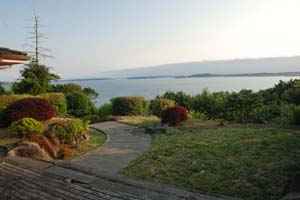Fallen giant
This Sunday was a very sad day for me. During a weekend visit to the property, we became aware that the beautiful, mature, giant Douglas fir tree standing majestically on the hillside next to us had snapped in half during a brief period of wind gusts on Saturday. For probably about 75 years, this beautiful tree has hosted bald eagles, osprey, and thousands of other birds scoping for prey, cleaning their feathers, or just enjoying a nice view of the Sound. I’ve seen as many as three bald eagles on this tree at once and it was one of the first things that attracted me to the property.

This guy got a few minutes of alone time before his buddies showed up.

This is what the tree looked like before this weekend.
The top portion of the tree had been dying for quite some time and I never expected any regrowth, but neither did I expect the 18-inch diameter upper trunk to snap completely in half during what I would consider fairly moderate winds. The right gust must have just hit the right angle for the right duration and the old guy cried uncle.

This is what the tree looks like today.

A close-up of the carnage.
We’re only four or five weeks away from finally moving in, so it’s incredibly sad to see our favorite element of the landscape decimated before we could really enjoy it, but on the bright side, the tree itself is still up, and what remains is alive and presumably well. It’s still high enough to where the eagles may come back (fingers crossed) but it just isn’t the same without those thick bare limbs providing the equivalent of park benches to our high flying neighbors.
First-world problems, yes, I know… but it’s still incredibly sad. I would have rather seen every piece of vegetation on my property go before that tree.


That is a sad day, but I guess you can be thankful that that chunk of tree didn’t fall on the house, (I’m not sure how close it is, so that may not be possible).
From my experience on the west coast, the eagles will be back. Maybe, if you put an eagle perch on your roof, they’ll actually come and visit your house.
That’s too bad, that was a great asset. I’d build a fake tree so they could hang out, out of a telephone poll or something similar. Probably wouldn’t be too expensive.
perhaps you can re-use part of it for a furniture piece or artistic element for the interior of your house (a salad bowl, etc..) nice to have that tree and the story behind it live on in some aspect in your new home….
John and Ryan: Yep, not a bad suggestion, but it would have to look good. Definitely don’t want a big telephone pole looking thing.
Lou: I think the wood has already been chucked off the cliff. :(
That is sad indeed. I wonder what caused that top part to die in the first place. Is there an arborist in the house?!
Nooooo!!!! The bald eagles are fabulous! I would buy another full grown tree even if it cost a few thousand dollars. Watching the eagles from your balcony is going to be such an experience.
That’s a shame!
At least the remaining tree has a decent shape.
If you decide to remove what’s left of the tree or if the tree continues to die back (definitely consult an arborist), consider getting a Cryptomeria, also known as a Japanese cedar. It’s also an evergreen and is a very hardy, beautiful and quick growing tree. Cryptomeria are great “swayers,” too, and would most likely be able to handle a good wind storm. My favorite cultivar is Yoshino.
Also, even though you are not looking for a landscaping challenge, your house may be in a decent climate for a California Redwood.
I’m looking forward to your next landscaping post which will hopefully provide a plant-by-plant breakdown and a landscaping drawing.
[…] about eagles, but I do know that before the top of a giant dead tree in my neighbor’s yard snapped off last year, we had eagles landing on it almost every week. Now, they just occasionally fly by and never seem […]
I’m very sorry that tree snapped. To help you build a suitable replacement perch, here are the numbers for your local Bald Eagle experts within the US fish and wildlife services:
Washington
Lacey (306) 753-9440
Spokane (509) 891-6839
Wenatchee (509) 665-3508
I found their numbers in the National Bald Eagle Management Guidelines–here’s the link to the pdf: http://www.fws.gov/pacific/eagle/NationalBaldEagleManagementGuidelines.pdf